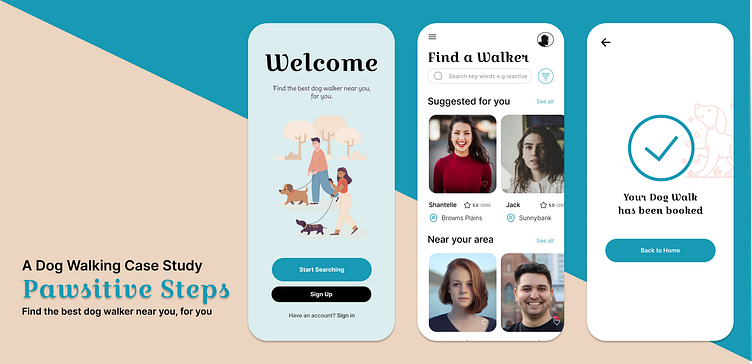Pawsitive Steps - A Dog Walking App Case Study
Pawsitive Steps is a mobile application created as part of the Dribbble Product Design Course, to efficiently bring together dog owners and trustworthy dog walkers.
Project Overview
Problem Statement
Finding dependable, secure and convenient pet care services through the internet can be challenging. What is the solution to developing a product that allows pet owners to securely connect with trusted pet sitters?
The Goal
Connecting dog owners with reliable and trustworthy dog walkers.
Making it easy for dog owners to schedule and manage walks for their pets.
Providing a platform for dog walkers to find and accept walking jobs.
Ensuring the safety and well-being of pets while they are being walked.
Offering a seamless and convenient experience for both dog owners and dog walkers.
Providing real-time updates and communication between dog owners, walkers and pets.
Streamlining the booking, payment and tracking processes for pet care services.
As a Product Designer, my main role was to create an app design and user flow to address the issue faced by dog owners. The process involved conducting user and market research, incorporating the findings into the wireframes, designs, and prototypes, and evaluating the usability of the app through testing with dog owners.
Understanding the user
User Research
User interviews were conducted on 3 dog owners between the ages of 20 to 35.
From the responses, the issue of trust was raised - a tendency to look to neighbours for pet care services because of this reason. This was also apparent with another dog owner, who isn't able to seek services due to the reactive nature of their dog.
The target user's expectations and motivations were illustrated and better understood through the use of user personas and empathy maps, based on research.
Market Research
An analysis was conducted on existing products currently in the market to assess whether our competitors were effectively addressing the pain points identified through user interviews.
User Flow
The app was designed to address both the presence of special needs and cost-effectiveness, based on user persona insights.
With an easy and efficient onboarding flow, users are able to start searching for dog walkers immediately without the need to create an account first.
To connect dogs requiring special care with trained walkers, users input individual pet information during account setup.
Visual Design
Wireframes
Following initial rough sketching on paper, multiple low-fidelity wireframe designs were created through iterative drafting.
Visual Design System
To reflect its focus on trust and reliability, Pawsitive Steps selected a color palette and typography that emphasize these values.
The use of pastel blue and cream hues with Croissant One font conveys a calming, friendly, trustworthy, and modern brand image.
Prototype
The Pawsitive Steps Figma prototype can be found here.
Usability Testing
The usability of Pawsitive Steps was evaluated to determine if the design met user needs and was intuitive. Participants found navigation simple, but encountered issues when booking a 45-minute walk. Recommendations for improvement include adding a calendar feature for selecting walk duration.
Takeaways and Next Steps
My key realization from this case study is that creating a successful product requires a comprehensive approach, beyond just aesthetics. This involves:
User-centered design: The app should meet the needs and expectations of the target users, and their feedback should inform design decisions.
Intuitiveness: The app should be easy to navigate and use, and its functionality should be straightforward.
Branding: The app should reflect the brand's values and identity, and the color palette, typography, and imagery should align with this.
Iterative design: The design process should involve multiple drafts and iterations, and low-fidelity wireframes can be used to explore design options before committing to a high-fidelity solution.
Accessibility: The app should be accessible to people with disabilities and follow accessibility guidelines, such as those from the Web Content Accessibility Guidelines (WCAG).
Testing: The app should be tested with real users to identify areas for improvement, and feedback should be used to iterate on the design.
And much more!
As I further develop Pawsitive Steps in Figma through additional iterations and enhancing user flows, I look forward to the pawsitive next steps I'll be taking myself, to bring this app to the next level.







